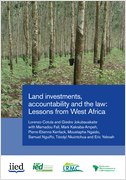Land investments, accountability and the law: Lessons from West Africa
The recent wave of land deals for agribusiness investments has highlighted the widespread demand for greater accountability in the governance of land and investment. Legal frameworks influence opportunities for accountability, and recourse to law has featured prominently in grassroots responses to the land deals.







